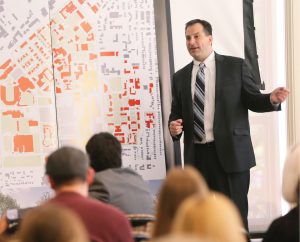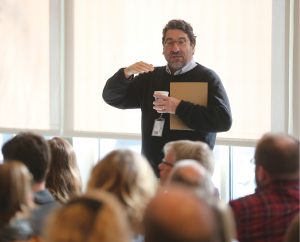A Plan for All Seasons: Vanderbilt Explores a Land-Use Plan That Drives Its Mission
Read the full Vanderbilt Magazine story here.
Furman Hall, the gray stone structure that many say was built inadvertently at Vanderbilt instead of Duke (a colorful story that unfortunately lacks much evidence) stands out for reasons other than its distinctive turrets. It was the only building constructed as part of a dramatic 1905 campus plan designed by George Kessler, a contemporary of Frederick Law Olmsted and the architect who oversaw the 1904 St. Louis World’s Fair.

Now, 110 years later, Vanderbilt is embarking on another land-use plan that will guide campus building during the next decade, if not far longer.
While the best-laid plans often change significantly when confronted with reality, the university is starting its latest campus land-use initiative not with a fixed blueprint like Kessler’s maps, but with a yearlong series of meetings with a wide array of Vanderbilt stakeholders. Instead of setting specific priorities about what to build or refurbish next, the university wants a roadmap for how to translate the priorities of the Academic Strategic Plan—along with fundamental values like inclusion, sustainability and discovery—into real-world construction, location and design standards.
“When we take on new endeavors as a university, and plan for our future, it is vital to remember that everything, from the blades of grass to our tallest building, must all center around our mission and humanistic values, which we must uphold,” Vanderbilt Chancellor Nicholas S. Zeppos says. “While this land-use process is one of planning, it’s also very much a project nested in the humanities. Whether somebody is working in the neonatal intensive care unit or the English or history of art departments, we are all indeed engaged in a humanistic project.”
 That may sound esoteric, but the key players involved have an impressive history of turning audacious visions into reality. Working closely with Zeppos is Eric Kopstain, vice chancellor for administration, a division that oversees the university’s operations. He brings an invigorating mix of affability and inquisitiveness to the hard-nosed business skills he honed at Northwestern (his alma mater), Dartmouth and Harvard. The university also has tapped the firm Pelli Clarke Pelli—whose co-founder, César Pelli, is a renowned former dean of the Yale School of Architecture—to undertake the land-use plan.
That may sound esoteric, but the key players involved have an impressive history of turning audacious visions into reality. Working closely with Zeppos is Eric Kopstain, vice chancellor for administration, a division that oversees the university’s operations. He brings an invigorating mix of affability and inquisitiveness to the hard-nosed business skills he honed at Northwestern (his alma mater), Dartmouth and Harvard. The university also has tapped the firm Pelli Clarke Pelli—whose co-founder, César Pelli, is a renowned former dean of the Yale School of Architecture—to undertake the land-use plan.
Martha Rivers Ingram is leading a working group from the Board of Trust that includes fellow member Jon Winkelried, a Vanderbilt parent who most recently was named co-CEO of the massive private equity firm Texas Pacific Group and served as a longtime Goldman Sachs executive. Along the way, famed Harvard Business School professor Michael Porter has offered counsel about how this latest land-use plan can enhance the school’s long-term strategy.
“Universities can be very inwardly focused, protective of the process, and protective of their own ways of doing things,” Fred Clarke, senior principal and co-founder of Pelli Clarke Pelli, told the audience at a daylong campus symposium on land-use planning in November, which was open to the Vanderbilt community. “It’s quite rare to see that inverted.”
First, the university’s separation from Vanderbilt University Medical Center—which divides the two institutions into separate legal entities and should be fully implemented in just a few months—changes how Vanderbilt thinks about future planning, including from a financial standpoint. Second, as Nashville’s commercial real estate market continues to boom, particularly in areas around campus, a greater need has arisen to ensure cooperation with private developers, neighboring communities and the city itself.
“We really want to look at areas where we can find win-win-wins,” Kopstain says, citing Vanderbilt’s successful rehabilitation of 100 Oaks Mall as an example.
Finally, the land-use plan would dovetail with the recently completed Academic Strategic Plan, which includes a focus on interdisciplinary collaboration, immersion learning and technological transformation, as well as with initiatives around diversity and sustainability.
Read the full article here.

Leave a Response